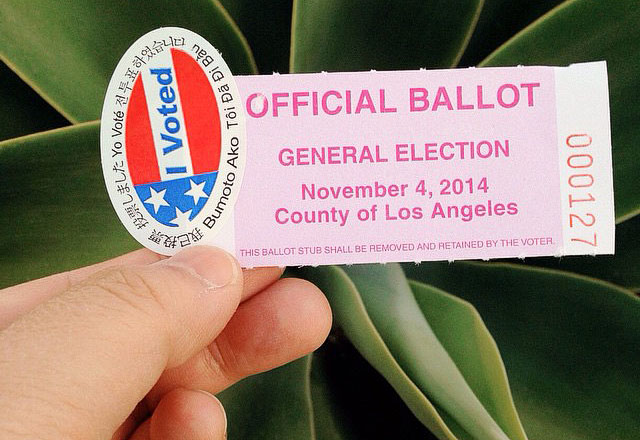Australians tend to associate US elections with hanging chads and other controversies arising from the 2000 US presidential election. Things have changed a bit since then, and I had the chance to see the electoral machinery in action as Americans voted in the midterm elections on Tuesday.
I spent the day as a poll-watcher in Los Angeles County, the largest electoral jurisdiction in the United States, visiting polling places and talking with poll-workers about their experiences. Over the course of the day I visited four polling stations: in Chinatown, Koreatown and central Pasadena, and at a residential polling place in someone’s garage in the city’s northern suburbs.
Having worked on the past two federal elections back in Australia, I was struck first of all by the lack of voters. While Australians usually have a short wait at most polling centres, the places I visited in Los Angeles County were queue-free. At the Koreatown booth, electoral officials told me that they were expecting around 150 votes between 7 am and 8 pm, or something like five an hour over the day. The precinct has around 1500 registered voters.
This modest turnout partly reflects the low salience of US midterm elections, which tests the parties’ capacity to persuade their supporters to cast a vote. This election certainly saw the Democrats struggle to mobilise their base among African-American, Latino and young voters. The Pew Research Center suggests that, nationally, just 13 per cent of voters were under thirty. The low turnout also reflected the fact that elections in California now largely take place before election day. This year, nearly three million Californians cast their ballot through the mail. (In some states, including Washington State and Oregon, voting takes place entirely by post.)
Of the booths I visited, turnout was highest in the garage in Altadena. I suspect many Australians would find voting at someone’s home a novel experience, and Australian electoral commissioners would no doubt cringe at the mere thought. But I saw nothing untoward in the process. Voters didn’t have to push past boxes or piles of old tools to get to the voting booths: the place was organised and clean and the officials working the station were experienced, having used the garage as a polling place at two previous elections. Everyone who voted was given cookies and a cold drink. Considering the difficult tasking of getting out the vote in the United States, establishing polling places in strategic locations close to large populations seems sensible.
Things have come a long way since 2000. The Help America Vote Act, or HAVA, was signed into law by President George W. Bush in 2002 and introduced minimum standards for US electoral administration. What I saw at the booths, particularly in Chinatown, reminded me a lot of the polling places I have worked at in Australia. There were clear administrative processes to follow regarding the handling and auditing of ballots, and the manager overseeing the process could, if necessary, call the county registrar direct with any problems. Most centres had staff who spoke Spanish or Chinese.
HAVA also led to the retirement of the dreaded Votomatic punchcard voting machines that featured in the photos from Dade County, Florida, after the 2000 election. In its place, Los Angeles County installed InkaVote in 2003, a new punchcard system based on a standalone lottery machine developed by International Lottery and Totalizator Systems. The voting cards really do look like the Oz Lotto cards you fill out if you decide to choose your own numbers: the typeface is very small and the process of voting looked a lot like someone attacking the ballot paper with a small, pointy hammer. At one polling place I visited, it took two voters over twenty-five minutes to complete their ballot. The ever-expanding size of Australian Senate ballot papers seems a relatively minor inconvenience by comparison.
All in all, I was surprised by what I saw on Tuesday. This appeared to be an election with few administrative hiccups. (There were reports of an errant polling official in Orange County using social media to post inappropriate pictures from a polling place, but this was cleared up quickly.) I was also surprised to learn that completed ballot cards are transported by the LA Police Department and County Sheriff to a central counting station for processing; this is viewed as the best way to ensure ballot security. Following the “missing” Western Australian votes at the 2013 federal election, this might be something the Australian Electoral Commission could investigate. •




